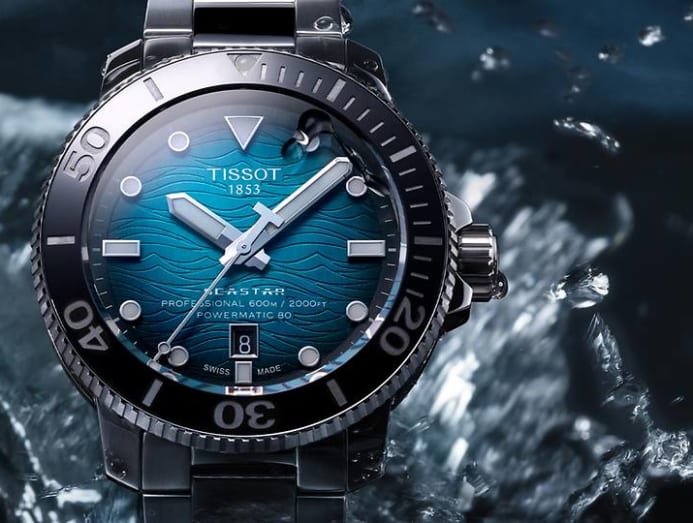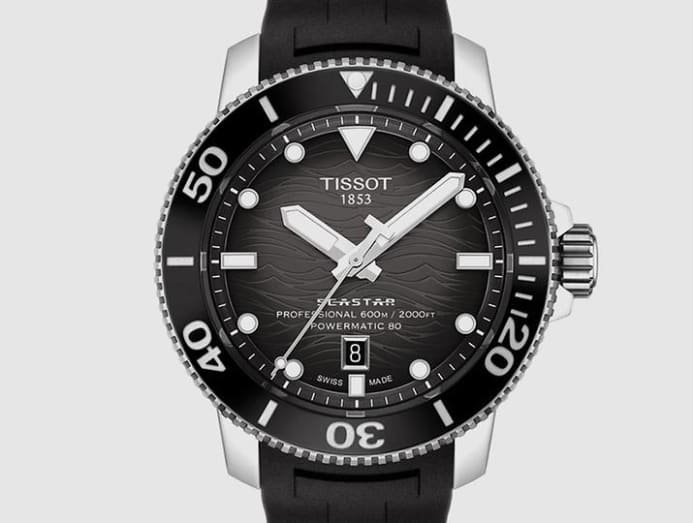Why are dive watches so popular even if – let’s face it – most of us don’t dive?
Tissot’s latest watch represents everything people love about these heavy duty timepieces.

Tissot's Seastar 2000 Professional. (Photo: Tissot)
Let’s face it: Mechanical watches are far from a necessity for daily life. They’re less accurate than their quartz-powered counterparts and have only a fraction of the functionality smart devices have.
And when you think about it, the subset of mechanical diving watches are even less so. Swimming pools are rarely deeper than 3m, and recreational diving has a maximum depth limit of 40m. Why on earth would you need a watch with a water resistance of a few hundred metres?
You don’t. But dive watches are as popular and trendy as ever – whether you’re talking about luxury pieces like Rolex’s Submariner, Seiko’s more affordable offerings, and everything in-between.
One recent entrant in the already-crowded market is Tissot’s Seastar 2000 Professional – and like many other divers, it’s a prime example of the general allure of this type of watch. We break down exactly why.

THEY’RE TOUGH AS NAILS
From a purely utilitarian point of view, this is basically a dive watch’s traditional selling point. Since timing is vital to a diver’s safety, such watches are built to resist knocks or shocks that might damage the movement inside.
The Seastar 2000, for example, is a whopper of a stainless steel monster with a diameter of 46mm and a thickness of 16.25mm. No doubt it’s an extreme example, even within this line, but that just underscores its point of being no-nonsense.
A screw-down crown and crown guards further ensure this particular piece stays true to its whopping 600m of water resistance – the depth rating required to achieve the ISO 6424 certification for dive watches.
Basically, it’s like showing up to a go-kart track in a tank – it’s excessive, but it’s nice to feel safe. Even in the pool.

YOU CAN TELL TIME IN THE DARK
Legibility is another default feature in proper dive watches. The time needs to be easily read in conditions as dark and murky as the sea (or when you suddenly wake up with the need to pee), so the numerals and hands are always big, bright and easy on the eyes.
Like most dive watches worth their (sea) salt, the Seastar 2000 achieves this with distinct hour indices and thick baton-shaped hands, all of which are filled with white luminescent material that glows blue in the dark. The date is prominently displayed through a window at six o’clock (not that you need to know what day it is underwater).
YOU CAN TIME THINGS WITH IT
A dive watch’s bezel also has a dedicated function. Being able to rotate, wearers can traditionally time their dives by aligning the minute hand to the desired numerals on the bezel. These typically only rotate in one direction – counter-clockwise – so that an accidental adjustment will only shorten the dive time as opposed to lengthen it.

Of course, when on land, you can also use it for other important things, like timing your cooking.
One important prerequisite for dive watch bezels is that they’re supposed to be easy to grip, which is important for actual divers who are geared up, gloved and in the water. These days, too, many bezels have replaced the old school aluminum material with the virtually scratch-proof ceramic insert.
THE DIVE WATCH DESIGN IS CLASSIC
Function dictates much of how a dive watch looks, and while that leads to many of them sharing a very similar aesthetic, it’s a formula that works well within the sporty category.
Dive watches don’t have a monopoly on ruggedness, what with pilot’s watches, chronographs and racing-inspired timepieces all vying for your adventure-seeking wrists, but they do have their own unique charm.
Some also have features you won’t find on other types of watches, like the Seastar 2000’s helium escape valve – an utterly obscure add-on that lets helium molecules escape during decompression following a saturation dive which, of course, isn’t so much a weekend hobby as it is a highly specialised profession.

THEY JUST LOOK COOL FOR ANY OCCASION
On the flip side, you can always look to how Daniel Craig pulls them off as he dons two different Omega Seamaster watches in Casino Royale – you’d know these rugged tickers can look slick in a suit, too.
The key to this versatility lies in the details. For the Seastar 2000, the dials are engraved with a wave pattern and come in smoky blue, black or green. There is even an option to switch between a rubber strap or a three-link steel bracelet.
READ: ‘I own 470 G-Shocks’: Exploring the obsessions of Singapore’s watch collectors
IF YOU’RE NOT GOING QUARTZ, THE MOVEMENTS ARE LOVELY
Some dive watches are quartz-powered and have a battery keeping them ticking. But mechanical ones have the added allure (and convenience) of movements, especially automatic ones with a self-winding mechanism.
Beating away inside the Seastar 2000 is the Powermatic 80 movement, which boasts an anti-magnetic hairspring to ensure optimal precision at all times. Automatic movements like this one will keep running for as long as you wear it, but even if you let the watch wind down, the Powermatic 80 has an above average power reserve of 80 hours.
You’ll even be able to admire the movement through the watch’s sapphire crystal caseback. This is a somewhat rare feature in a dive watch since many use solid casebacks, but it is wonderful reminder that this a proudly analogue tool in an eminently digitised world.





